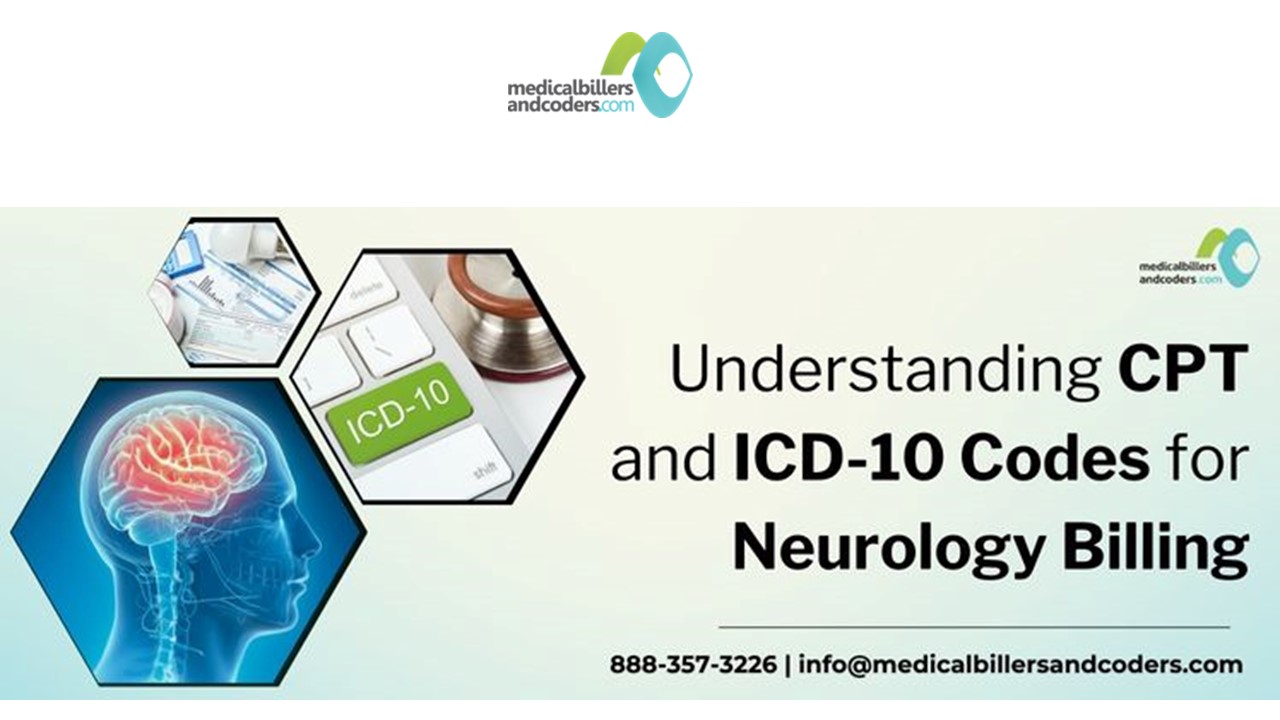Understanding CPT and ICD-10 Codes for Neurology Billing - PowerPoint PPT Presentation
Title:
Understanding CPT and ICD-10 Codes for Neurology Billing
Description:
Understanding CPT and ICD-10 codes for neurology billing can seem complicated, but it doesn't have to be. Our guide simplifies these concepts, making them easy to grasp for anyone. Whether you're experienced in the field or just starting out, our straightforward approach ensures clarity at every step. – PowerPoint PPT presentation
Number of Views:0
Title: Understanding CPT and ICD-10 Codes for Neurology Billing
1
(No Transcript)
2
Understanding CPT and ICD-10 Codes for Neurology
Billing
- Understanding CPT and ICD-10 Codes for neurology
billing is vital to getting adequate compensation
for medical services. Neurology billing and
coding services are challenging, and this article
aims to give you relevant information on the
issue. Furthermore, it will discuss its
importance in the healthcare business. In
addition, we will discuss the benefits of
outsourcing, the significance of CPT and ICD-10
codes, commonly used codes, and strategies to
tackle challenges in the neurology billing
business. - The Benefits of Outsourcing Neurology Billing and
Coding Services - There are various benefits to contracting
out neurology billing and coding services - More revenue and stability in your finances
- Decreased billing errors and denials
- Better risk management and compliance
- Access to specialized knowledge
3
Understanding CPT and ICD-10 Codes for Neurology
Billing
- Significance of CPT and ICD-10 Codes in Neurology
Billing Practices - To guarantee correct billing, CPT codes
appropriately reflect neurological operations and
treatments. ICD-10 codes are used to classify
neurological illnesses for simplicity of record
keeping. By standardizing billing using these
codes, healthcare systems may become more
consistent, error-free, and financially correct.
They improve communication among insurers,
regulators, and healthcare practitioners. - CPT and ICD-10 codes also allow for comprehensive
data analysis in research and resource
allocation. By assisting with treatment planning
and result evaluation, their use enhances patient
care. Effective Neurology Billing enhances
clinical care and financial control and requires
the use of CPT and ICD-10 codes. - Commonly used CPT Codes
- 95829-95836 Electrocorticography
- 95851-95857 Range of Motion Testing
4
Understanding CPT and ICD-10 Codes for Neurology
Billing
- 95860-95872 Electromyography Procedures
- 95905-95913 Nerve Conduction Tests
- 95919-95924 Autonomic Function Testing Procedures
- 95925-95937 Evoked Potentials and Reflex Testing
Procedures - Commonly used ICD-10 codes
- G35 Multiple sclerosis.
- G40 Epilepsy.
- 1 Anoxic brain damage, not elsewhere classified.
- 9 Degenerative disease of the nervous system
- G10 Huntingtons Disease
- G20 Parkinsons Disease
- 0 Muscular Dystrophy
- 61 Intraspinal Abscess And Granuloma
5
Understanding CPT and ICD-10 Codes for Neurology
Billing
- Healthcare professionals should consult the most
recent coding regulations and documentation
requirements from credible sources such as the
American Medical Association. - Challenges in Neurology Billing and Coding
- Neurology billing and coding provide various
issues for healthcare providers - Compliance with regulations Following the
requirements of insurance companies and
government agencies such as CMS is critical to
avoiding rejections and legal complications. - Keeping up with code changes Neurology billing
codes change, demanding continuing knowledge to
avoid mistakes and successfully manage income. - Disorder complexity Neurological illnesses can
be difficult to diagnose and code accurately,
resulting in payment delays or denials. - Detailed documentation Billing accuracy is
dependent on exact and HIPAA-compliant paperwork
inadequate documentation might result in claim
denial.
6
Understanding CPT and ICD-10 Codes for Neurology
Billing
- Strategies for Tackling the Challenges
- To solve neurology billing and coding concerns,
healthcare providers may employ the following
strategies - Training Providing specialist training to
billing and coding professionals ensures a
thorough awareness of neurology-specific codes
and regulations, which reduces mistakes and
ensures compliance. - Documentation Excellence By placing a strong
emphasis on complete and accurate patient
records, precise coding and efficient claim
filing are encouraged, which enhances billing
accuracy and reimbursement. - Technical Integration Utilizing robust EHR and
billing software streamlines processes, automates
coding, and boosts productivity in managing
revenue and filing claims. - Continuous Audit and Tracking By keeping an eye
on billing procedures and conducting routine
internal audits, errors and compliance issues can
be found early on, leading to proactive
correction and improved financial performance.
7
Understanding CPT and ICD-10 Codes for Neurology
Billing
- To end,
- For neurology practices to maximize revenue and
guarantee compliance with healthcare standards,
accurate billing and coding are crucial. To
increase financial stability and lessen
administrative strain, think about contracting
out your neurology billing and coding needs to
qualified experts. With Medical Billers and
Coders, you choose a reliable neurology billing
business that supports the objectives and demands
of your clinic. Consult us today
at info_at_medicalbillersandcoders.com or call us
at 888-357-3226. - FAQS
- What are CPT and ICD-10 codes?
- CPT (Current Procedural Terminology) codes are
used to document medical procedures and services,
while ICD-10 (International Classification of
Diseases, 10th Revision) codes classify diagnoses
and reasons for patient encounters.
8
Understanding CPT and ICD-10 Codes for Neurology
Billing
- How are CPT codes used in neurology billing?
- CPT codes in neurology billing specify the
procedures and services provided during patient
visits, such as neurological examinations,
diagnostic tests, treatments, and surgeries. - What types of procedures do CPT codes cover in
neurology? - CPT codes cover a range of neurology procedures,
including EEG, EMG, nerve conduction studies,
neuroimaging (MRI, CT scans), nerve blocks, and
neurostimulator programming. - How are ICD-10 codes used in neurology billing?
- ICD-10 codes in neurology billing specify
diagnoses and reasons for patient encounters,
aiding in accurate billing and insurance claims
processing. - What types of diagnoses do ICD-10 codes cover in
neurology? - ICD-10 codes cover various neurological
diagnoses, including stroke, epilepsy, multiple
sclerosis, Alzheimers disease, Parkinsons
disease, migraine, and neuropathy.

